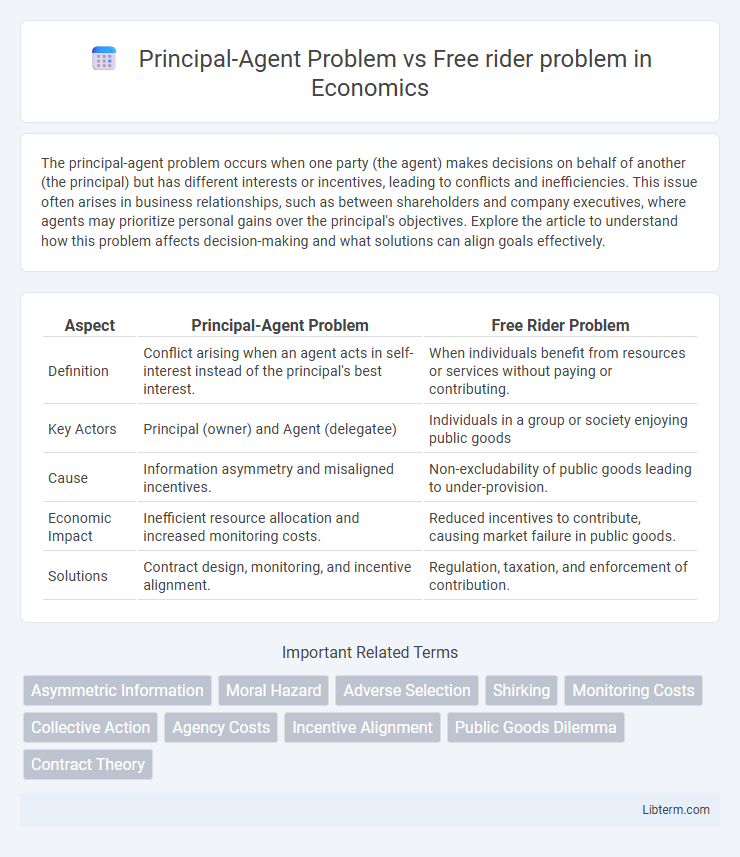The principal-agent problem occurs when one party (the agent) makes decisions on behalf of another (the principal) but has different interests or incentives, leading to conflicts and inefficiencies. This issue often arises in business relationships, such as between shareholders and company executives, where agents may prioritize personal gains over the principal's objectives. Explore the article to understand how this problem affects decision-making and what solutions can align goals effectively.
Table of Comparison
| Aspect | Principal-Agent Problem | Free Rider Problem |
|---|---|---|
| Definition | Conflict arising when an agent acts in self-interest instead of the principal's best interest. | When individuals benefit from resources or services without paying or contributing. |
| Key Actors | Principal (owner) and Agent (delegatee) | Individuals in a group or society enjoying public goods |
| Cause | Information asymmetry and misaligned incentives. | Non-excludability of public goods leading to under-provision. |
| Economic Impact | Inefficient resource allocation and increased monitoring costs. | Reduced incentives to contribute, causing market failure in public goods. |
| Solutions | Contract design, monitoring, and incentive alignment. | Regulation, taxation, and enforcement of contribution. |
Introduction to Principal-Agent and Free Rider Problems
The Principal-Agent Problem arises when a principal delegates work to an agent whose interests may not align, causing inefficiencies due to asymmetric information and moral hazard. The Free Rider Problem occurs when individuals benefit from resources or services without contributing to their provision, leading to underproduction or depletion of shared goods. Both problems highlight challenges in managing incentives and cooperation in economic and organizational contexts.
Defining the Principal-Agent Problem
The Principal-Agent Problem occurs when one party (the agent) is expected to act on behalf of another (the principal) but has conflicting interests, leading to issues of moral hazard and information asymmetry. This problem arises in various contexts such as corporate governance, where managers (agents) may prioritize personal gain over shareholders' (principals') interests. It contrasts with the Free Rider Problem, where individuals benefit from resources or services without contributing their fair share, focusing on collective action and public goods challenges.
Understanding the Free Rider Problem
The free rider problem occurs when individuals benefit from resources, goods, or services without paying for their cost, leading to under-provision and inefficiency in public goods. Unlike the principal-agent problem which centers on conflicts of interest and information asymmetry between a principal and an agent, the free rider problem highlights challenges in collective action and shared responsibility. Solutions to the free rider problem often involve government intervention, mandatory contributions, or incentivizing voluntary participation to ensure equitable resource allocation.
Key Differences Between Principal-Agent and Free Rider Problems
The Principal-Agent problem arises from conflicts of interest and asymmetric information between a principal and an agent, where the agent may not act in the best interest of the principal. The Free Rider problem occurs in public goods scenarios where individuals benefit from resources without contributing to their provision, leading to underinvestment. Key differences include the Principal-Agent problem focusing on contractual relationships involving delegation and monitoring costs, while the Free Rider problem centers on collective action and the challenge of ensuring voluntary contributions.
Causes of the Principal-Agent Problem
The Principal-Agent Problem arises primarily from information asymmetry, where the agent possesses more information than the principal, leading to hidden actions or moral hazard. Conflicting incentives between principals, who seek maximum returns, and agents, who may prioritize personal benefits, exacerbate the issue. Limited monitoring and enforcement capabilities further contribute to the problem, causing inefficient decision-making and resource allocation.
Causes of the Free Rider Problem
The Free Rider Problem arises primarily from the non-excludability of public goods, where individuals benefit without contributing to the cost, leading to under-provision of those goods. Unlike the Principal-Agent Problem, which centers on asymmetric information and conflicting incentives between a principal and an agent, the Free Rider Problem stems from collective action challenges and the absence of effective enforcement mechanisms. This problem is exacerbated in situations where individual contributions are difficult to monitor or reward, reducing motivation to cooperate.
Real-World Examples of Principal-Agent Problem
The principal-agent problem frequently arises in corporate governance, where shareholders (principals) hire managers (agents) to run a company but face challenges ensuring managers prioritize shareholder interests over personal gains. Real-world examples include CEO compensation packages that incentivize short-term stock price boosts rather than long-term company performance, as seen in cases like the Enron scandal and the 2008 financial crisis. This problem contrasts with the free rider problem, which typically appears in public goods contexts where individuals benefit from resources without contributing to their provision or maintenance.
Real-World Examples of Free Rider Problem
The free rider problem occurs when individuals benefit from resources, goods, or services without paying for them, commonly seen in public goods such as national defense, public parks, and clean air. For instance, in public broadcasting, viewers enjoy programming without contributing financially, leading to underfunding and reliance on donations or government support. Another example is vaccination programs, where some individuals rely on herd immunity without getting vaccinated, potentially jeopardizing public health outcomes.
Solutions and Mitigation Strategies
Implementing performance-based incentives and enhancing transparency significantly reduce the Principal-Agent Problem by aligning agents' interests with principals' goals. To mitigate the Free Rider Problem, strategies such as imposing participation requirements, using selective incentives, and fostering group norms enhance individual contribution motivation. Both challenges benefit from robust monitoring systems and clear communication channels to ensure accountability and cooperation.
Implications for Organizations and Policy Makers
The Principal-Agent Problem generates inefficiencies in organizations due to misaligned incentives between managers and stakeholders, necessitating monitoring mechanisms and incentive alignment to ensure goal congruence. The Free Rider Problem challenges collective action within organizations and policy settings by reducing individual contributions to public goods, requiring policies that encourage participation or penalize non-cooperation. Both problems underscore the importance of designing governance structures and regulatory frameworks that mitigate opportunistic behavior and promote organizational accountability and efficiency.
Principal-Agent Problem Infographic

 libterm.com
libterm.com